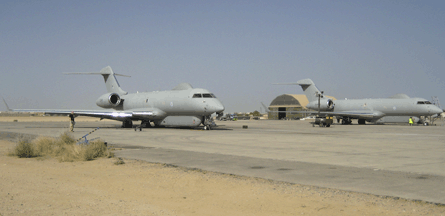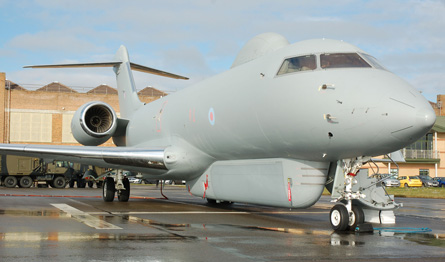The UK's new Sentinel R1 battlefield surveillance aircraft had a successful first deployment over Afghanistan late last year, providing imagery of a wide area of territory and operating in collaboration with air assets and ground forces, says Gp Capt Harry Kemsley, commanding officer of the Royal Air Force's 5(AC) Sqn.
Two of the heavily modified Bombardier Global Express business jets, which form part of the UK's new airborne stand-off radar (ASTOR) system, were deployed to a base in the Middle East for the trial, held in November and December, which totalled 19 missions.
The Raytheon Systems-developed aircraft used their dual-mode radars to capture more than 107h of ground moving target indication (GMTI) data and almost 150 detailed synthetic aperture radar images, says Kemsley. The latter included surveying routes and compounds of interest, while the GMTI mode was used to collect information such as "pattern of life" intelligence.
 |
|---|
© Crown Copyright |
Other roles demonstrated during the sorties, which in some cases lasted for more than 10h, included screening ahead of tactical operations and providing force protection.
"One of the key outputs from ASTOR that was frequently recognised by the soldier on the ground was our ability to look over the horizon and tell him what's coming round the corner," says Kemsley. "The flexibility of the system surprised them," adds British Army Maj Will Tosh, detachment commander for the recent trials.
The Sentinels were also used to cross-cue Elbit Systems Hermes 450 unmanned air vehicles and RAF British Aerospace Nimrod MR2 reconnaissance aircraft to look at objects of interest with their optical sensors.
Operational analysis is now looking at the detailed results of the ASTOR system's performance, and at the ability to fuze GMTI and SAR imagery.
Raytheon delivered the last of five Sentinel R1 airframes to RAF Waddington in Lincolnshire on 10 February (below). Full operational capability is expected to be achieved by 5 Sqn in around two years, but with some ASTOR ground station equipment still in Afghanistan, the aircraft is likely to return to theatre sooner.
 |
|---|
© Craig Hoyle/Flight International |
"The system was sufficient to go on operation, and we have a proven capability to do it again," says Kemsley. Two of 5 Sqn's current four crews, from an eventual total of 10, achieved combat-ready status during the recent deployment.
Raytheon declines to comment on the level of compensation it has paid the UK Ministry of Defence in relation to the ASTOR programme, which is around two years late. However, minister for defence equipment and support Quentin Davies confirms: "The delay has been largely paid for by Raytheon."
Meanwhile, Raytheon ASTOR programme director Rob Crook says the company has held "very early discussions" with the MoD over possible co-operation that could see the customer support its interest in competing for the US Army's revived aerial common sensor acquisition.
The company believes that the certificated Sentinel airframe could accommodate the service's electronic intelligence requirement.
Source: Flight International
















